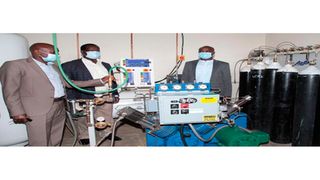
Biomedical engineer Alex Rono explains oxygen production, at a processing plant at Longisa County Referral Hospital, to Bomet County's medical services executive Dr Joseph Sitonik and Governor Hillary Barchok, on April 2, 2021.
| Vitalis Kimutai | Nation Media GroupBomet
Premium
Bomet oxygen plant set up before Covid-19 now South Rift’s saviour
What you need to know:
- Bomet’s plant produces 9,000 litres of oxygen per hour at a facility set up at Longisa County Referral Hospital in 2014.
For the last three months, the Bomet County government has been supplying the excess oxygen it produces to public and private hospitals in the South Rift region free of charge.
The county has set the tempo producing and supplying oxygen amid shortages reported in public and private hospitals across the country with the reported surge in Covid-19 infections, leading to overstretched facilities.
Bomet’s plant produces 9,000 litres of oxygen per hour at a facility set up at Longisa County Referral Hospital in 2014.
The oxygen supply far exceeds the demand in its 134 health facilities spread across Bomet East, Bomet Central, Konoin, Sotik and Chepalungu constituencies.
The county government procured the plant for Sh15 million seven years ago before the Covid-19 pandemic struck and pushed up the demand for oxygen in hospitals.
Former Bomet Governor Isaac Ruto decided to procure the plant after a reported case of a grandmother and grandchild who were admitted to a hospital in critical condition. To save their lives, doctors were to put them on oxygen supply.
But, unfortunately, the hospital had a shortage of oxygen and doctors decided to put only the grandchild on oxygen, leading to the death of the elderly woman.
Mr Ruto wanted to ensure health centres in the region got adequate supply to save lives.
No shortages
Siloam hospital in Kericho County and St Clare Kaplong hospital in Bomet County are the main consumers of the supplies from the county government, Governor Hillary Barchok said.
“We produce more oxygen than we require in our health facilities and have not faced any shortages even with the surge in Covid-19 infections compared with our neighbouring counties,” he said.
“We are willing in the spirit of devolution to supply other counties with oxygen in order to save lives.”
Oxygen is connected to 60 of the 224 Covid-19 isolation beds at Koiwa sub-county hospital, and another 34 at Longisa hospital in Bomet County.
Narok and Kericho counties are said to have made inquiries for supplies but are yet to place any orders.
“We are appealing to the benefitting health facilities who are receiving the supplies free of charge not to bill their patients for the essential commodity. Our interest is to ensure lives are saved,” said Dr Barchok in an interview with Nation.Africa.
Dr Stanley Kiplangat, the Medical Superintendent at St Clare’s hospital, Kaplong, said the facility receives an average of 10 cylinders a week from Bomet for free.
“Alternately, we dispatch five cylinders each at a time to Longisa county referral hospital for refilling twice a week to meet the demand from patients,” he said.
The facility operated by the Catholic Church is in Kaplong in Sotik constituency and serves patients from the five counties of Bomet, Kericho, Narok, Kisii and Nyamira.

Bomet Governor Hillary Barchok (centre), Chief of Staff William Kiprotich (left), Kembu MCA Joseph Kelong, nominated MCA Marcelah Chepkirui and Deputy Governor Shdrack Rotich durign a press conference at the county headquarters on May, 21, 2021.
No extra charges
The hospital has for the last one and a half years been using an average of 150 litres of oxygen per week, which is supplied free of charge by the devolved government unit.
“We do not charge extra levies to the patients receiving oxygen, save for the daily rebates of Sh3,000 covered by the National Hospital Insurance Fund (NHIF),” Dr Kiplangat said.
Oxygen used by patients is supplied to anaesthetic machines and ventilators in hospitals or directly connected to patients by a flow metre and tubing.
Kericho County hospital has set aside Sh67 million in the 2021/2022 fiscal year to build an oxygen plant, according to Dr Patrick Mutai, the County executive for Finance and Economic Planning and head of county treasury.
“Once the plant is operational, Kericho County will be self-sufficient with cheaper oxygen, with the surplus being supplied to neighbouring counties and private health facilities in what will be a revenue-generating project,” Dr Mutai said.
Mr Barnabas Ngeno, the acting CEC for Health, said the money will be used to build a structure, install oxygen plant equipment and piping, supply oxygen cylinders and buy motor vehicles for transporting the cylinders to other health facilities in the county.
A number of counties in the Rift Valley, Nyanza and Western Kenya regions have faced oxygen shortages in their health facilities, with several Covid-19 patients succumbing to complications while waiting for treatment.

Kakamega Governor Wycliffe Oparanya addresses the press at the county headquarters in Kakamega town on July 7, 2021, when he announced an oxygen shortage in the county.
County challenges
Kakamega has experienced challenges because the plant it has produces only 380 litres per minute, leading the devolved unit to procure another plant from France for Sh100 million with a capacity to produce 1,000 litres per minute.
Vihiga County’s facility was damaged by an electrical fault, destroying a Sh30 million facility.
Kenya Power is said to have asked the county to upgrade electricity supply for Sh5.1 million before the electrical glitch that damaged the plant was reported.
Major hospitals, including Kenyatta National Hospital, are some of the facilities that have seen shortages.
It was revealed recently that KNH required 8,000 litres of oxygen but the supplies stood at 3,000 litres.
Health Cabinet Secretary Mutahi Kagwe is on record saying that only 16 per cent of the demand was supplied by public health facilities.
He said the demand for oxygen had risen to 560 tonnes from the previous average of 410 tonnes when Covid-19 struck Kenya last year.




